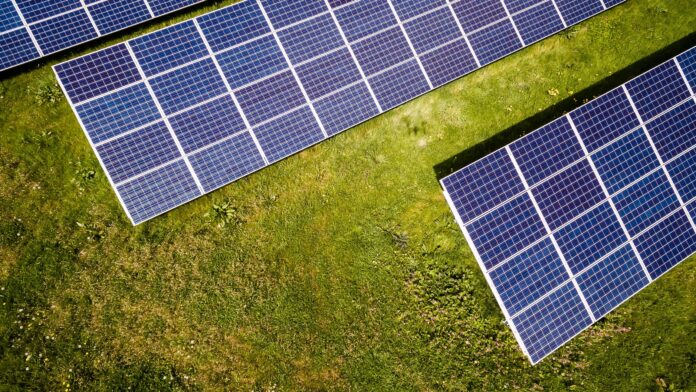Agrivoltaics, also known as solar farming or agrophotovoltaics, is an innovative approach that combines agricultural practices with solar energy production. It involves the coexistence of agricultural activities and photovoltaic (PV) systems on the same land, allowing for the simultaneous generation of crops and solar power. This integration of agriculture and solar energy offers numerous benefits, including increased land productivity, efficient land use, water conservation, and renewable energy generation.
In agrivoltaic systems, solar panels are installed above the crops, providing shade to the plants while capturing sunlight to produce electricity. The panels are typically mounted on structures that allow for adjustable heights and tilting angles to optimize sunlight exposure. By harnessing solar energy, farmers can generate clean electricity for their own use or supply it to the grid, contributing to the transition towards a sustainable energy future.
Now let’s delve into ten important aspects and considerations related to agrivoltaics:
1. Increased Land Productivity: Agrivoltaics enhance land productivity by effectively utilizing the same land for both agriculture and solar energy generation. The shading provided by solar panels reduces excessive evaporation, thus conserving water and creating a microclimate that can benefit certain crops. Research has shown that agrivoltaic systems can lead to higher crop yields and reduced water requirements.
2. Efficient Land Use: By combining agriculture and solar energy production, agrivoltaics optimize land use efficiency. Rather than using separate land areas for farming and solar installations, the dual-purpose approach maximizes the utilization of available land resources. This becomes particularly relevant in areas with limited land availability or high land costs.
3. Crop Protection and Quality: The shading provided by solar panels in agrivoltaic systems offers protection to crops from extreme weather conditions such as excessive heat, hail, or heavy rain. This shade can help regulate temperature and prevent crop damage, leading to improved crop quality and reduced risk of crop failure.
4. Water Conservation: Water scarcity is a significant concern in agriculture, especially in arid and semi-arid regions. Agrivoltaics can help address this issue by reducing water evaporation from the soil surface due to the shade provided by solar panels. Studies have demonstrated that agrivoltaic systems can result in significant water savings compared to conventional farming practices.
5. Enhanced Energy Production: Agrivoltaic systems enable the production of renewable energy while utilizing land that may not be suitable for large-scale agriculture. By harnessing solar energy, farmers can generate electricity for their own use, reducing their reliance on the grid and lowering energy costs. Surplus energy can also be supplied to the grid, contributing to the overall renewable energy capacity.
6. Climate Change Mitigation: The integration of agriculture and renewable energy generation offered by agrivoltaics contributes to climate change mitigation efforts. By displacing fossil fuel-based electricity generation with clean solar energy, agrivoltaic systems reduce greenhouse gas emissions, thereby mitigating climate change impacts.
7. Economic Viability: Agrivoltaics can provide additional revenue streams for farmers, increasing their economic viability. In addition to income from crop sales, farmers can benefit from the sale of surplus electricity produced by the solar panels. The financial returns from agrivoltaics can help diversify and stabilize farm incomes.
8. Research and Development: The field of agrivoltaics is relatively new and offers ample opportunities for research and development. Ongoing studies are investigating the optimal configurations of solar panels, crop selection, and management practices to maximize both energy and agricultural outputs. Continued research will contribute to refining agrivoltaic techniques and expanding their applicability.
9. Policy Support: Governments and policymakers play a crucial role in promoting the adoption of agrivoltaic systems. By implementing supportive policies such as financial incentives, streamlined permitting processes, and research funding, policymakers can encourage farmers and investors to embrace agrivoltaics. Policy support can help accelerate the deployment of agrivoltaic projects, drive innovation, and create a favorable environment for sustainable agriculture and renewable energy production.
10. Community Engagement and Education: Agrivoltaics not only offer environmental and economic benefits but also provide opportunities for community engagement and education. These systems can serve as educational tools, showcasing the integration of renewable energy and sustainable agriculture to local communities, schools, and visitors. By raising awareness and understanding, agrivoltaics can inspire individuals to adopt more sustainable practices in their own lives.
Agrivoltaic systems hold tremendous potential, but there are also some considerations and challenges to address:
a. Technical Optimization: To maximize the benefits of agrivoltaics, it is essential to optimize the design and configuration of the system. Factors such as the height and tilt angle of solar panels, spacing between panels, and choice of crops need to be carefully considered to achieve the optimal balance between energy production and crop yield.
b. Crop Selection and Management: The selection of crops plays a vital role in agrivoltaics. Certain crops are better suited for growing under shade, while others may require more sunlight. It is crucial to choose crops that can thrive in the specific microclimate created by the solar panels. Additionally, crop management practices need to be adapted to the unique conditions of agrivoltaic systems.
c. Maintenance and Operation: Regular maintenance of agrivoltaic systems is essential to ensure optimal performance. This includes cleaning solar panels, monitoring for any technical issues, and managing the crops effectively. Farmers and solar energy operators need to be trained in both agricultural and solar system maintenance practices to ensure the long-term success of agrivoltaic projects.
d. Economic Considerations: While agrivoltaics offer economic benefits, the initial investment costs can be a barrier for some farmers. The installation of solar panels and associated infrastructure requires capital investment, which may not be feasible for all farmers without financial support or incentives. Access to financing options and financial incentives can play a crucial role in promoting the widespread adoption of agrivoltaics.
e. Land Availability and Access: The availability of suitable land for agrivoltaic projects can be a constraint, particularly in densely populated areas or regions with high competition for land use. Additionally, access to land and land tenure issues may pose challenges to implementing agrivoltaics. Addressing these factors requires collaboration between farmers, landowners, policymakers, and renewable energy developers.
f. Local Regulations and Grid Integration: Local regulations and grid integration policies can significantly impact the feasibility of agrivoltaic projects. Streamlined permitting processes, favorable net metering policies, and grid interconnection arrangements are crucial for the successful integration of agrivoltaic systems into the existing energy infrastructure.
g. Environmental Impact Assessment: As with any form of land use, agrivoltaics should undergo environmental impact assessments to ensure that the implementation of solar panels and associated activities do not have adverse effects on the local ecosystem, biodiversity, or water resources. Careful planning and monitoring can help mitigate any potential negative impacts.
h. Knowledge Sharing and Collaboration: Agrivoltaics is a rapidly evolving field, and sharing knowledge and best practices is essential for its growth. Collaboration among researchers, farmers, policymakers, and industry stakeholders can facilitate the exchange of experiences, lessons learned, and innovations, leading to the continuous improvement and expansion of agrivoltaic systems.
In conclusion, agrivoltaics represents a promising approach that combines agriculture and solar energy production, offering a range of benefits including increased land productivity, efficient land use, water conservation, and renewable energy generation. While agrivoltaics present opportunities for sustainable farming and clean energy production, there are considerations and challenges that need to be addressed. Through ongoing research, policy support, and collaboration,














